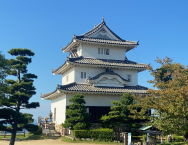Morning Exercise 24 April 2024
Radio Taiso Daisuki
Things get going early in En. Every morning since I have come here, the village loudspeaker springs into life at 6.30am. It is time for Radio Taiso.
Rajio taisou (ラジオ体操) literally means “health radio” and is a series of simple physical exercises broadcast on NHK radio (the Japanese equivalent of the BBC). It actually dates back to 1928, but was suspended for a while by the occupying American forces after the war, apparently because it was felt to be a bit too military. But it came back in a renewed form in 1951 and has remained roughly the same ever since.
Radio Taiso is quite popular all over Japan. I had first encountered it when, during early morning walks in Kagawa, I would run across groups of people gathering outside community centres or in public parks. I read that they would switch on a portable radio and exercise together. But it was not until my first morning in En that I heard it broadcast, giving me a bit of a surprise so early in the day. Later still, I read that practice varies across Japan. It used to be common for it to be broadcast over town loudspeaker systems, but that has become less and less common. Some municipalities even restrict the kinds of noise you can make early in the morning, so anyone wishing to follow Radio Taiso would have to do so more discretely.
Having heard it, I wondered if people gathered somewhere to exercise to it. A few days later, I spotted the arms of someone appearing sporadically over a wall, indicating that they were exercising in one of our narrow streets. It was quite a few days later before I plucked up the court - and the energy - to go and find out what was going on. Sure enough, every morning a small number of people gather outside the community centre and exercise together, though I suspect others do it in the privacy - and in Winter the warmth - of their own homes. The broadcast is certainly audible inside every house.

A local resident gets up every morning and switches the loudspeaker to broadcast the radio. It was she who first greeted me and from whom I learned the exercise moves by copying. As far as I can tell, she has been doing this without fail, rain or shine, every day that I have lived here. En being on the wild stormy coast of the island, there’s quite a lot of rain, wind with the occasional typhoon, but that hasn’t seemed to deter her. Sometimes, I am guessing, she exercises alone but of course I would not know.
When I have the energy to go, it has been a useful way to get to know some of the villagers. In the Summer holidays, there was quite a crowd. The younger children had “stamp cards” to be stamped for doing particular activities during their holiday. They could get stamps for coming to Radio Taiso every day for a week and so of course they did, bringing parents or elder siblings with them. When asked what they would get for filling in all the stamps, we were told homeru (praise), so I guess that the stamps are a little like the gold stars given by my primary school teachers in my youth.
Almost everymorning the broadcast follows the same pattern. One of a pair of presenters, alternatively a man or woman, opens with a morning greeting and then introduces ラジオ体操の歌 (“rajio taisou no uta” or “exercise radio song”). Although you can find many versions of it online, I cannot find the one that is broadcast to us, but I did manage to find one on youtube sung by its composer Ichirō Fujiyama who is obviously having a lot of fun. I think it gives a feel for the broadcast version.
The presenter first talks you through a simple exercise action that seems to vary from day to day and then, with declares with glee rajio taisou daisuki (I/we love Radio Taiso). Exercise music starts and then daily routine starts: a series of exercises, each repeated to the count of eight. My knowledge of Japanese body parts and their orientations is not quite up to following the instructions, which is why it was essential to have someone to copy. There is actually a second sequence, more focused on building of arm muscle, which I am told is usually skipped by most people doing the exercises. By now I am not surprised that En is unusual in doing both.
Then it is over. We all shake ourselves down a little. Busy people hurry away to their day’s activities, but sometimes there are some who stay and chat a little. I always take the opportunity to if I can to practice my rudimentary Japanese.
Last year, the lady who organises Radio Taiso every day introduced me to her mother, aged 99. If you spend much time in rural Japan you will not be particularly surprised. You will see many people busily working in fields who appear to be in their 70s or 80s. The first neighbour I met in Kagawa was busily tending to one of her rice fields as I walked past. She cheerfully introduced herself and I learned she was aged 85. How do these people live so long and stay so fit? Maybe Radio Taiso is part of that story.
Extra
The lyrics of rajio taisou no uta are
新しい朝が来た 希望の朝だ
喜びに胸を開け 大空あおげ
ラジオの声に 健(すこ)やかな胸を
この香る風に 開けよ
それ 一 二 三
Which Google Translate translates as:
A new morning has come, a morning of hope
Open your heart with joy and let the sky rise
A healthy heart to the voice on the radio
Open to this fragrant wind
That one two three
